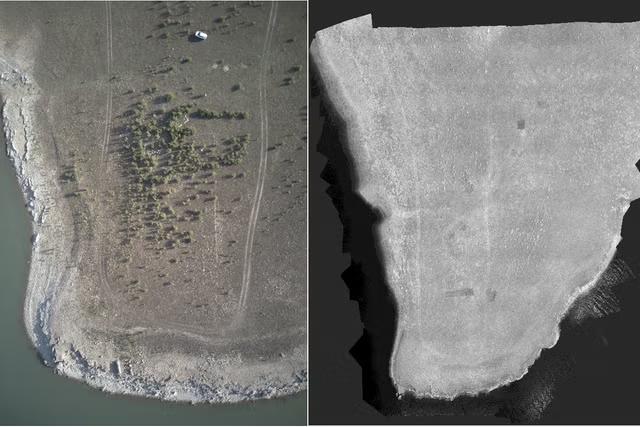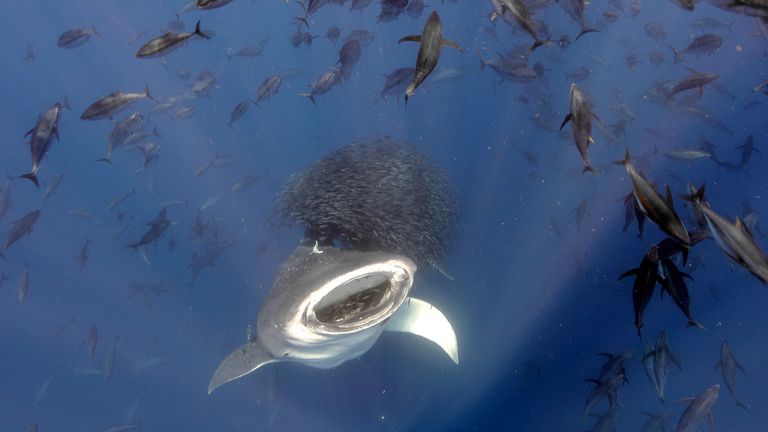The water levels of the Colorado River have been dropping lower than forecasted for decades, mystifying scientists.
Now, researchers may have figured out that spring rainfall may be the cause, according to a new paper in the journal Geophysical Research Letters.
Researchers predict the amount of water available in the Colorado River based on the amount of snowpack that accumulates in the Rockies over the winter, but since the year 2000, the water levels have consistently been lower than predicted. This discrepancy may be down to lower levels of precipitation in the spring months, the researchers suggest.
According to the paper, 70 percent of this missing water may be accounted for by springs becoming drier over the past 20 years or so.
During the winter months, snow accumulates in the mountains, particularly in the Rocky Mountains. As temperatures rise in the spring, the snowpack begins to melt, flowing down the mountain slopes as surface runoff, and traveling through small streams and tributaries, until it reaches larger rivers like the Colorado.
"It is understood that somewhere in the range of 70-80 percent of the Colorado River's water starts out as snow in the mountains. Since 2000, there has been a marked 20 percent decline in Colorado River streamflow," study co-author Daniel Hogan, a researcher at the University of Washington, Seattle, told Newsweek. "It is difficult to pinpoint exactly how much water originated as snow vs. other sources, but our research suggests that its possible the contribution from the snowpack has decreased."
If there is less rain in the spring, the plants nearby rely on the snowpack melt for water as opposed to rain, meaning that less water overall enters the streams, and eventually the rivers. Less spring rain also means that sunnier weather is more likely to have occurred, increasing plant water use and the evaporation of water from the soil.
"We observed that much of the Colorado headwaters, where streamflow that feeds the Colorado originates, has seen a significant decrease in spring precipitation since 2000 that was not seen in other seasons. This timing also aligned with the stark declines in streamflow observed in the Colorado River," Hogan said. "We found the loss of spring precipitation had two effects: less precipitation fell, which obviously reduces streamflow, and plants and trees that normally rely on spring precipitation to bolster their growth later on in the year can only rely on water coming from the winter snowpack to grow, resulting in less snowmelt water ending up in streams."
The researchers describe how they initially thought that sublimation—the process by which snow or ice turns directly into water vapor—could explain the missing water. However, they discovered that this process was only responsible for 10 percent of the water loss.
"There are only so many possible culprits, so I started to compare things that might be important," study co-author Jessica Lundquist, a UW professor of civil and environmental engineering, said in a statement. "And we saw that springtime changes are a lot more exaggerated than they are in other seasons. It's this really dramatic shift where you're going from feet of snowpack to wildflowers blooming over a very short amount of time, relatively speaking. And without spring rains, the plants — from wildflowers to trees — are like giant straws, all drawing on the snowpack."
The researchers modeled how much water the plants along 26 headwater basins that run into the Colorado use.
"We make an important assumption in the paper," Hogan said. "We assume that the plants have an unlimited amount of water even with less-than-average precipitation, because they have access to snowmelt."
They found that the models showed reduced streamflow if there was less springtime rain, with the greatest deficit in basins at lower elevations.
The reduction in springtime rain may be due to the megadrought that has been impacting Colorado and other southwestern states since the turn of the millennium.
"The reasons behind this change is not entirely apparent," Hogan said. "Most likely, a shift towards warmer and drier springs can be linked to year-to-year variability. However, climate change may play an important role here, but unfortunately not enough research has been conducted focusing on long term climate impacts on spring precipitation in the region. If it can be shown that climate change distinctly impacts spring precipitation, then streamflow declines can be expected to continue."
In the future, this water loss in the Colorado River may impact the levels of Lake Mead and Lake Powell, both important reservoirs that provide water and hydroelectric power to millions of people.
"If dry springs continue to occur, it can be expected that water levels continue to decline precipitously. The winter season plays a vital role for mediating streamflow and deserves the attention it has gotten, but our work highlights that spring acts as a critical bridge between the wet, cool months and the warm summer months. Thus, understanding the impacts spring weather conditions have on water availability has an important role to play for Colorado River water storage," Hogan said.
These findings may impact the way we calculate the water available for the year, as this measurement is usually taken in April after the snowpack hits its peak.
"April is when everybody wants to know how much water is in the snowpack each year," Lundquist said. "But the problem with doing these calculations in April is that obviously spring hasn't occurred yet. Now that we know spring rain is actually more important than rain any other times of the year, we're going to have to get better at predicting what's going to happen rain-wise to make these April predictions more accurate."
Do you have a tip on a science story that Newsweek should be covering? Do you have a question about snowpack? Let us know via science@newsweek.com.
References
Hogan, D., & Lundquist, J. D. (2024). Recent upper Colorado River streamflow
declines driven by loss of spring precipitation. Geophysical Research Letters, 51, e2024GL109826. https://doi.org/10.1029/2024GL109826
Disclaimer: The copyright of this article belongs to the original author. Reposting this article is solely for the purpose of information dissemination and does not constitute any investment advice. If there is any infringement, please contact us immediately. We will make corrections or deletions as necessary. Thank you.



